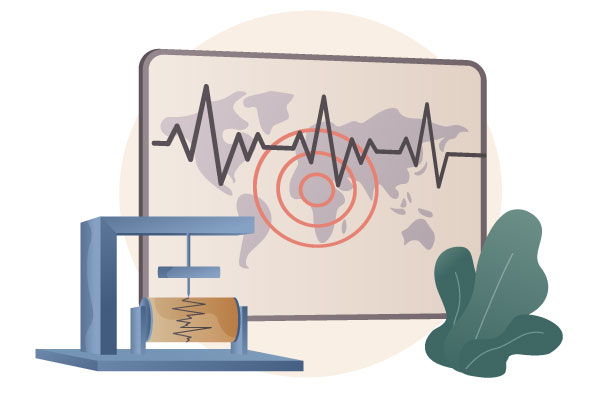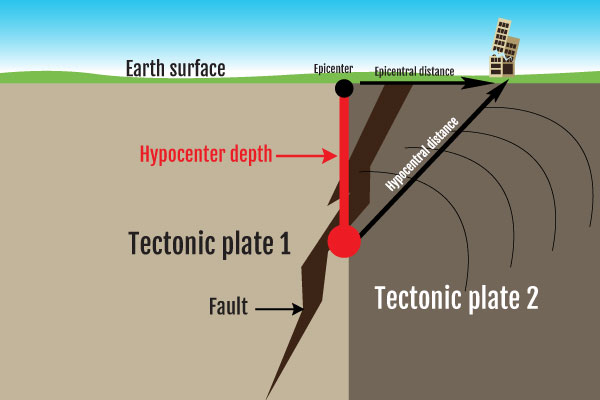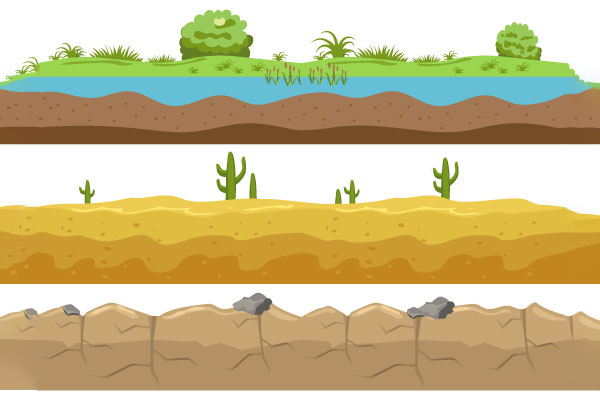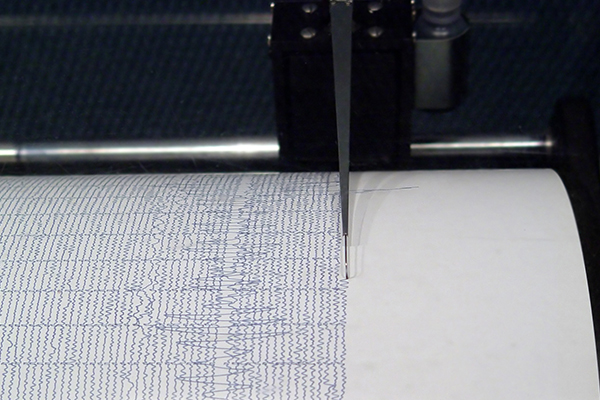What Determines the Duration of an Earthquake?
Earthquakes are typically short, with the ground motion of most earthquakes lasting just 10 to 30 seconds, but some earthquakes can last much longer.
The longest earthquake ever recorded was the Sumatran-Andaman earthquake off the coast of Indonesia, which struck on December 26th, 2004. This earthquake “had the longest duration of faulting ever observed” with shaking reportedly lasting between eight and ten minutes.
In California, earthquake durations vary widely. The 1857 Fort Tejon quake, one of the largest ever recorded in California, reportedly had shaking that lasted between one and three minutes. In 1906, the Great San Francisco Earthquake had less than 42 seconds of shaking. And the 1994 Northridge quake lasted only 20 seconds.
What caused some of these earthquakes to last so long? And what factors influence an earthquake’s duration? This blog explains everything you need to know about how long earthquakes last.
Factors Influencing Earthquake Duration
Several factors influence the length of an earthquake, but first, let’s define what we mean when we refer to an earthquake’s length.
The terms “length” and “duration” can be used interchangeably for earthquakes, and both refer to the length of time that an earthquake occurred. But there are two ways to think about how long any particular earthquake lasts.
In the words of the Alaska Earthquake Center, when asked about how long an earthquake was, you could ask “Do you mean the earthquake itself or the shaking you feel under your feet?”
As the USGS puts it, “Earthquakes occur on faults…when…the rock on one side of the fault slips with respect to the other.” The length of time it takes for the rock to move within the area of the fault is one way to measure the length of an earthquake.
But the more common way to think about the duration of an earthquake is to consider how long the ground shook following the fault’s rupture. This is what most people think about when they talk about how long an earthquake lasts because this is the part of the earthquake that people can actually feel.
For this article, we’ll use the second definition: how long the ground shook after the fault ruptured. With that in mind, what factors cause some earthquakes to last longer than others?
Magnitude, Intensity, and Energy Release
The size of the earthquake plays an important role in determining how long it lasts.
According to the Pacific Northwest Seismic Network, “how long earthquakes last varies depending on the size of the earthquake.” The USGS agrees, writing “The duration of an earthquake is related to its magnitude.”
In short, large earthquakes tend to last longer than shorter ones, and two relatively recent and infamous earthquakes prove this point perfectly.
The Great Alaskan Earthquake of 1964 recorded a magnitude of 9.2, and shaking was reported to last around 3 minutes. The Loma Prieta Quake of 1989 recorded a magnitude of 6.9, and shaking was reported to last around 15 seconds.
It’s also important to remember that an earthquake doesn’t have to be long to be dangerous and destructive. The 1994 Northridge Earthquake only lasted 20 seconds, but 57 people were killed and at least 8,700 were injured. In addition, thousands of homes, apartments, and mobilehomes were destroyed or damaged, displacing about 22,000 people and causing almost $35 billion in damage (adjusted for inflation). No matter an earthquake’s duration, California residents should consider a seismic retrofit to protect their loved ones and their homes from earthquake damage.
The size of an earthquake isn’t the only thing influencing how long it lasts. In the USGS article linked above, it’s also explained that “the duration of shaking is a very complex topic.” In fact, there are several other factors besides size that can influence an earthquake’s duration. Let’s explore those other factors.
Distance from the Epicenter
An earthquake’s epicenter is the “location on the surface of the Earth directly above where the earthquake starts.” And while it may seem counter-intuitive, people farther away from an earthquake’s epicenter are likely to report that the earthquake lasted longer than those who were closer to the epicenter.
Why is this? The USGS explains that “high frequency waves lose energy more quickly than low frequency waves…and the further you are from an earthquake the more the low frequency shaking dominates what you feel.” The LA Times writes that an earthquake’s “higher frequency waves…cause the sudden jolts…but the low-frequency waves roll along…causing the ground to roil.”
To experience this effect, visit the USGS’s page about earthquake distance effects, where you can listen to two seismometer recordings that were taken at different distances from the same earthquake’s epicenter. You’ll hear that the recording from the closer seismograph station sounds like a faster “sharp jolt,” while the recording made from the station farther away from the epicenter sounds like a longer “rolling motion.”
To summarize, people closer to an earthquake’s epicenter are likely to experience an earthquake as being larger or more powerful, but shorter-lasting. And people farther away from an earthquake’s epicenter are likely to experience the same earthquake as being less powerful, but longer lasting.
Soil & Rock Types
The type of soil and rock that an earthquake’s seismic waves travel through before reaching the surface of the earth also impacts how long the earthquake lasts. As the Alaska Earthquake Center explains, “Seismic waves travel slower through looser, less consolidated material, so the shaking lasts longer than in places with more rigid material.”
They explain that loose soils, sandy soils, and soils saturated with water are also more likely to shift, or even “jiggle like jello,” after seismic waves have passed through them. This can cause the ground above those areas to shake for a longer period, leading to longer-lasting earthquakes.
As a result, areas with harder and more densely packed materials are likely to experience shorter earthquakes. And areas with softer and more loosely packed materials are likely to experience longer earthquakes. This is why people at the same distance from any particular earthquake’s epicenter can report that the shaking lasted for different lengths of time.
This becomes especially important when considering the potential for earthquake damage. Earthquakes can turn loosely packed, water-saturated soil to liquid, in a process known as “liquefaction.” Liquefaction can cause major damage to homes and buildings, causing them to sink into the ground by inches or even feet. In some cases, this can render a home or building completely uninhabitable.
Many parts of California, including the Bay Area, are especially susceptible to liquefaction. This was demonstrated in the 1989 Loma Prieta earthquake, which turned wet, sandy soil to liquid, and caused significant damage in the Marina District of San Francisco, where 35 buildings were completely destroyed (PDF).
How Are Earthquake Durations Recorded?
When an earthquake occurs and the ground begins to shake, this shaking is recorded by an instrument called a seismograph. The recording made by the seismograph is called a seismogram. The seismogram produces a record of how much shaking occurred, and how long that shaking lasted. For full details on how these instruments work, see the USGS’s page on how earthquakes are recorded.
Are Aftershocks Included in an Earthquake’s Duration?
Some earthquakes generate aftershocks, which are small earthquakes that tend to follow the initial rupture of a large or moderate earthquake. The aftershock sequence can last for dramatically different lengths of time, with some that “may be as short as a few weeks or as long as a few decades.” When we talk about how long any particular earthquake lasts, we don’t typically include the aftershock sequence in the earthquake’s duration.
Why Aren’t Earthquake Durations Reported?
The USGS does not report earthquake durations on their website, but why? As we noted above, earthquake durations are a complex topic. First, there are two different ways to think about an earthquake’s duration; how long the earthquake actually took to occur vs. how long someone felt the ground shaking. And because the length of time the ground shook depends on where the person who felt the shaking was located, the length of any particular earthquake varies depending on from where it’s being reported.
What Was the Longest Earthquake Ever Recorded?
The longest official earthquake on record was the 2004 Sumatran-Andaman earthquake of the coast of Indonesia, which caused shaking that was reported to last between eight and ten minutes. But the longest ever recorded seismic event was the 32 year-long “slow-slip event” in Sumatra. This technically doesn’t count as an earthquake, but this event “ended with an 8.5 magnitude earthquake in 1861.” For full details on the differences between earthquakes and slow-slip events, see Penn State’s page on slow slip events.
What Can I Do to Protect My Home & Family from Earthquakes?
To protect your home and your loved ones from earthquakes, we recommend creating an earthquake preparedness plan.
Your plan should include creating an earthquake emergency kit, reading about the 7 essential earthquake safety tips, and viewing the California earthquake probability map to find out if you live near an active fault. Consider downloading the free MyShake App which can give you an early warning if earthquake shaking is imminent.
If you are a homeowner in California, your preparedness plan should also include finding out if your house needs an earthquake retrofit. Retrofits can significantly improve your home’s resilience against earthquakes, making it much more likely to survive a major seismic event.
Remember that earthquake preparedness can save lives, and that the best time to prepare for an earthquake is well before the ground begins to shake!
For additional tips, advice, and more information about earthquakes, visit our Seismic Strong Blog.




